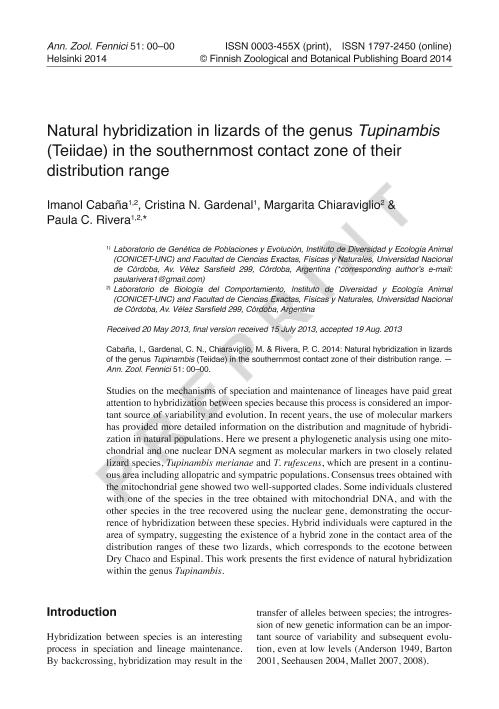Artículo
Natural hybridization in the lizard of the genus Tupinambis (Teiidae) in the southernmost contact zone of their distribution range
Fecha de publicación:
06/2014
Editorial:
Finnish Zoological Botanical Publishing Board
Revista:
Annales Zoologici Fennici
ISSN:
0003-455X
Idioma:
Inglés
Tipo de recurso:
Artículo publicado
Clasificación temática:
Resumen
Studies on the mechanisms of speciation and maintenance of lineages have paid great attention to hybridization between species because this process is considered an important source of variability and evolution. In recent years, the use of molecular markers has provided more detailed information on the distribution and magnitude of hybridization in natural populations. Here we present a phylogenetic analysis using one mitochondrial and one nuclear DNA segment as molecular markers in two closely related lizard species, Tupinambis merianae and T. rufescens, which are present in a continuous area including allopatric and sympatric populations. Consensus trees obtained with the mitochondrial gene showed two well-supported clades. Some individuals clustered with one of the species in the tree obtained with mitochondrial DNA, and with the other species in the tree recovered using the nuclear gene, demonstrating the occurrence of hybridization between these species. Hybrid individuals were captured in the area of sympatry, suggesting the existence of a hybrid zone in the contact area of the distribution ranges of these two lizards, which corresponds to the ecotone between Dry Chaco and Espinal. This work presents the first evidence of natural hybridization within the genus Tupinambis.
Archivos asociados
Licencia
Identificadores
Colecciones
Articulos(IDEA)
Articulos de INSTITUTO DE DIVERSIDAD Y ECOLOGIA ANIMAL
Articulos de INSTITUTO DE DIVERSIDAD Y ECOLOGIA ANIMAL
Citación
Cabañas, Imanol; Gardenal, Cristina Noemi; Chiaraviglio, Margarita; Rivera, Paula Cecilia; Natural hybridization in the lizard of the genus Tupinambis (Teiidae) in the southernmost contact zone of their distribution range; Finnish Zoological Botanical Publishing Board; Annales Zoologici Fennici; 51; 3; 6-2014; 340-348
Compartir




